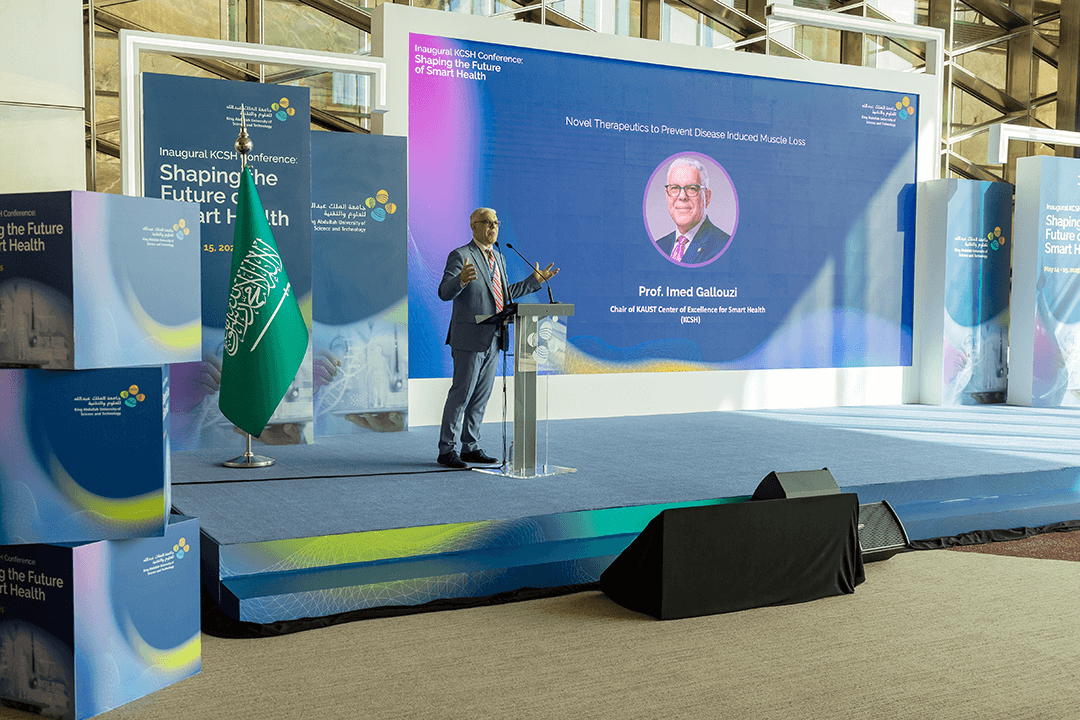Transforming Saudi Arabia’s healthcare system

KAUST is supporting the Kingdom in healthcare modernization by translating laboratory research into smart, digital, and precise solutions. Through bold, interdisciplinary initiatives, the University is bringing high-impact innovations to market, aligning with the best aspirations of Saudi Vision 2030.
“A vibrant society and an ambitious nation must have a foundation of good health,” KAUST President Sir Edward Byrne AC told the inaugural KCSH Conference: Shaping the Future of Smart Health. Drawing on his long career in healthcare research, he emphasized the importance of harnessing AI, bioengineering, genomics, data science, and smart technology to deliver high-impact solutions for human health. In his expert opinion and experience, KAUST and its Center of Excellence for Smart Health are global leaders in this field.
“Beyond research, we are investing in translational science. Many of our supported innovations are advancing toward commercialization. Rapid diagnostic kits, wearable health technologies, and digital tools for early disease detection — these are poised to benefit Saudi Arabia and global markets.”
Professor Ahmed Eltawil, Electrical and Computer Engineering, highlighted his lab’s Social and Personal Adaptive Response Kit (SPARK) — a revolutionary technology integrating AI-driven behavioral analysis, wearable multi-sensor systems, and human body communication. It enables real-time monitoring, providing contextual feedback and early behavioral intervention that can support children with autism.
Autistic children often display repetitive, socially isolating behaviors, noted Eltawil. SPARK’s body-based sensors can track when, the duration, and the context in which these behaviors occur.
By capturing contextual data via sensors such as IMU’s and GPS, the system provides therapists with actionable insights beyond limited therapy sessions, helping tailor interventions effectively and affordably. Meanwhile, SPARK’s AI chatbot gently redirects repetitive thoughts and tracks conversational progress.
“Taken together, SPARK aims to offer a comprehensive platform and infrastructure to support behavioral tracking and cognitive redirection,” he said. “Ultimately, it enhances therapy outcomes for autistic children.”
Wearable technology is a recurring theme of KAUST’s smart health solutions. For example, researchers have developed a fully printed wireless electrocardiogram system and a smart bandage for various applications. These low-cost, versatile devices enable continuous, real-time health monitoring and are made possible through additive manufacturing, advancing personalized, remote care as part of the “Health Internet of Things” revolution.
“These sensors can be printed on flexible and unconventional kinds of materials,” said Professor Atif Shamim, Electrical and Computer Engineering. Designed with a full battery system and hardware for the wireless interface interacting with apps, he added, this disposable, wireless system shows comparable results to incumbent, less convenient options. “We are now trying to do clinical trials of this technology in hospitals.”
Skin deep innovation
Emulating nature, Professor Nazek El-Atab, Electrical and Computer Engineering, and her team have developed a sustainable, glue-free skin patch. Fabricated using dual-3D printing, the stretchable, breathable biopatch adheres comfortably to various skin types without residue. It supports reliable medical monitoring during movement, offering a biocompatible, high-performance alternative to traditional adhesive-based wearables.
“We were inspired by the octopus’s suction cups, which allow it to grip various surfaces,” she said. “We printed microscale versions of these structures onto our patch, enabling it to adhere to skin without chemical adhesives. To improve comfort, we embedded microfluidic channels, letting sweat evaporate, making it suitable for long-term wear.”
Professor Dana Alsulaiman, Material Science and Engineering, is advancing precision and personalized healthcare through smart, materials-driven platforms. Her team’s work includes 2D material-based electrochemical biosensors for minimally-invasive detection of biomarkers for rapid disease detection and monitoring.
She also leads research on a painless microneedle patch for targeted transdermal drug delivery, unlocking new possibilities for a variety of applications.
“This non-invasive microneedle platform overcomes many limitations in traditional drug delivery approaches,” Alsulaiman said. “While we delivered large proteins as a proof-of-concept, this versatile platform unlocks many possibilities in cosmetics, therapeutics, and vaccine delivery.”
Intelligent healthcare
Empowering healthcare professionals is central to KAUST’s smart health mission. Bioscience Professor Jesper Tegnér and his team are advancing biomedical research through AI tools and targeted training. To bridge data science and life sciences, KAUST has launched hands-on courses and a popular Coursera program. Now, Tegnér and his team are developing a new effort to teach AI using accessible, code-assisted platforms.
“The real shift is putting that data into the hands of people who have the questions — giving them the tools to reason through these complex systems,” he said. “This sets the stage for making medicine truly effective.”
Continuing the focus on autism research, Bioscience Professor Leena Ibrahim’s lab is studying sensory processing — at a synaptic and circuit level — from a neurodevelopmental perspective. Her team is investigating how disruptions in these pathways lead to the sensory hypersensitivities often observed in autism.
Using mouse models, her team explores how the brain integrates sensory input with context and memory, and how system imbalances can impair perception. She said: “To study this, we use tools such as viral vectors to manipulate specific cells or circuits in the brain — including inhibitory neurons — and observe how these changes affect sensory processing. We also use CRISPR to edit genes and examine how specific mutations influence brain function.”
Ibrahim added: “Ultimately, we aim to integrate data on neuronal activity, gene expression, and behavioral patterns to develop AI models that interpret brain function in individuals with autism. The long-term goal is to create closed-loop sensor systems capable of supporting diagnosis and intervention by decoding brain signals in real time.”
Growing hope for cachexia treatment
Cachexia, a severe muscle-wasting condition associated with cancer, chronic diseases, and aging, has long eluded effective treatment. However, Professor Imed Gallouzi, Chair of the KAUST Center of Excellence for Smart Health (KCSH), has shared findings from his laboratory that bring renewed hope.

Professor Imed Gallouzi, Chair of the KAUST Center of Excellence for Smart Health, presents breakthrough findings during the inaugural KCSH Conference: Shaping the Future of Smart Health.
His team has uncovered a pivotal role for inducible nitric oxide synthase (iNOS) in driving muscle loss associated with cachexia. Using a combination of genetic and pharmacological approaches, the team demonstrated that inhibiting iNOS not only prevents muscle atrophy and loss, but also restores protein synthesis in preclinical models.
Remarkably, the researchers identified two novel compounds that surpass the efficacy of existing iNOS inhibitors, offering significant therapeutic promise. This groundbreaking work aligns fully with the KCSH mission to deliver transformative solutions to some of the most pressing health challenges of our time.
In his closing remarks at the KCSH conference, Gallouzi emphasized that meaningful progress in health innovation demands collaboration, not isolation. “Strong ideas, clearly defined problems, and capable interdisciplinary teams, spanning technology, biology, and healthcare, are essential.”
He added: “When we put our minds together and see the results, the future looks bright. I foresee many more good things coming from the Center of Excellence for Smart Health.”
Alongside fellow KAUST researchers, Gallouzi underscored the importance of resourceful, collaborative innovation. These combined efforts reflect KAUST’s unwavering commitment to building a smarter, healthier future — for the Kingdom and the world.

